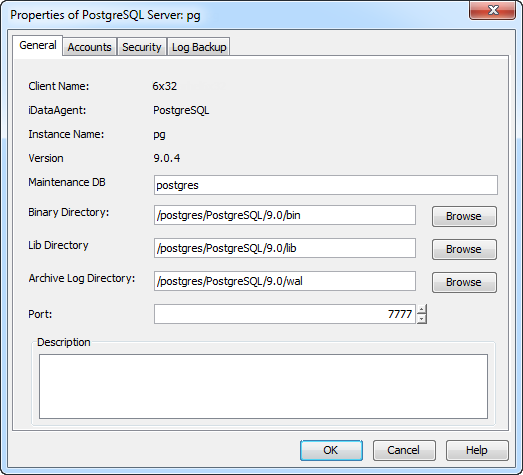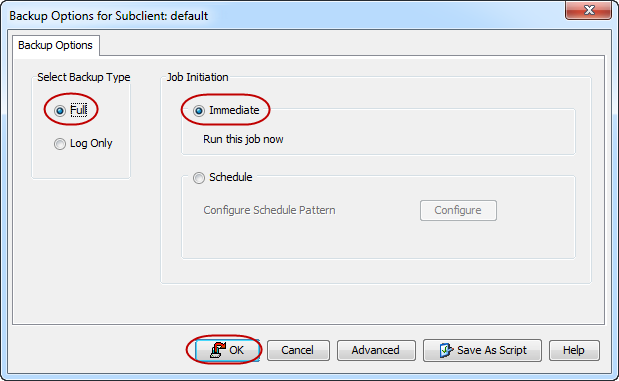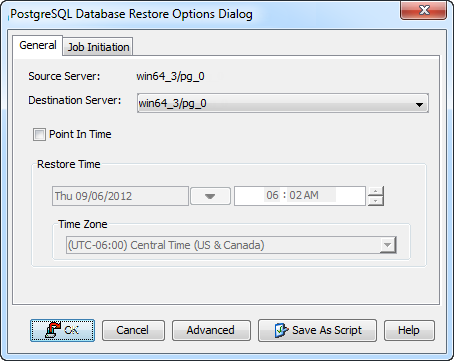Audit Trail
The Audit Trail feature allows you to track the operations of users who have access to the CommCell. This capability is useful if a detrimental operation was performed in the CommCell and the source of that operation needs to be determined.
Audit Trail tracks operations according to four severity levels:
-
Critical: This level records operations that will result in imminent loss of data.
-
High: This level records operations that may result in loss of data.
-
Medium: This level records changes to the general configuration of one or more entities. Such changes may produce unintended results when operations are performed.
-
Low: This level records changes to status, addition of entities, and other operations that have minimal impact on existing CommCell functions.
To set Audit Trail retention periods:
-
From the Home tab in the CommCell Console, click Control Panel and then, from the Monitoring options, click Audit Trail.
-
From the Audit Trail dialog box, select the desired retention time (in days) for each severity level.
-
Click OK.
For details, see Audit Trail.
Auxiliary Copy
An auxiliary copy operation allows you to create secondary copies of data associated with data protection operations, independent of the original copy.
-
Expand the Policies node, right-click storage policy for which you want to perform an auxiliary copy, click All Tasks, and then click Run Auxiliary Copy.
-
If you are starting the auxiliary copy operation from the CommServe level, select the storage policy for which you wish to perform the auxiliary copy.
Note
If you are starting the auxiliary copy operation from the Storage Policy level, the Storage Policy field is already populated with the name of the Storage Policy you selected.
-
If the source copy is configured with a shared library, select the Source MediaAgent for the auxiliary copy.
-
Click OK to start the auxiliary copy operation. A progress bar displays the progress of the operation.
For details, see Auxiliary Copy.
Operating System and Application Upgrades
Operating system upgrades are only supported when upgrading from one version of an OS to a different version of the same OS (e.g., Win2003 to Win2008). The two methods of upgrading are:
-
Seamless Upgrade - This involves uninstalling the Agent software, upgrading the operating system, and then re-installing the Agent software.
-
Full OS Replacement - This involves performing a clean install of a new version of the OS, re-installing any application software, then re-installing the CommServe, MediaAgent, and/or Agent software.
For Full OS Replacement, the client computer must be configured to have the CommServe, MediaAgent, and/or Client software re-installed to the same location, the same Fully Qualified Domain Name or short domain name, the same partitions, disk drive format (FAT, NTFS, et. al.), and IP configuration as previously.
If it is necessary to remove Agent software to facilitate an operating system or application upgrade, do not delete the icon for the Agent from the CommCell Console, or all associated backed up data will be lost.
Use the following strategy to upgrade the operating system software:
-
Identify the computers you want to upgrade and the CommCell components installed on each of these computers.
-
Choose the type of upgrade procedure you want to use on each computer: seamless or full replacement.
-
CommServe, MediaAgent, and Client computers can be upgraded in any order.
For details, see Operating System and Application Upgrades.
Pre Version Upgrade Considerations for PostgreSQL Application
Run at least one log only backup before upgrading the PostgreSQL application to a newer version or before changing the data directory location.
Post Version Upgrade Considerations for PostgreSQL Application
You can upgrade PostgreSQL application to a newer version on both Windows and Unix platforms. Post upgrade, use the following steps to perform the first backup or restore:
Instance Configuration
Use the following steps to modify the PostgreSQL binary directory path, library directory path and archive log directory path when you upgrade the PostgreSQL application to a newer version. For further information, click Managing Instances.
-
From the CommCell Browser, navigate to Client Computers | <Client> | PostgreSQL.
-
Right-click the <instance>, and then click Properties.
-
In the Binary Directory box, type the path to the Binary directory. Alternatively, click Browse to select the path. The PostgreSQL Binary Directory is generally located under the PostgreSQL install directory.
For Example:
For Windows, the path would be similar to C:\Program Files\PostgreSQL\9.0\bin
For Unix, the path would be similar to /opt/PostgreSQL/9.0/bin
-
In the Lib Directory box, type the path to the Lib directory. Alternatively, click Browse to select the path. The PostgreSQL Lib Directory is generally located under the PostgreSQL install directory.
For Example:
For Windows, the path would be similar to C:\Program Files\PostgreSQL\9.0\lib
For Unix, the path would be similar to /opt/PostgreSQL/9.0/lib
-
If you are using a different WAL directory in the newer version, then type the new Archive Log Directory path.
-
Click OK.

Backup
After upgrade, the first backup performed on a FSBasedBackupSet subclient should be a full backup. A full backup must be performed before a log backup can be initiated. For further information on backups, click Advanced Backup - PostgreSQL iDataAgent.
Use the following steps to run a full backup on a FSBasedBackupSet subclient:
-
From the CommCell Browser, navigate to Client Computers | <Client> | PostgreSQL | <Instance> | <FSBasedBackupSet>.
-
Right-click the<Subclient>and click Backup.
-
Select Full as the backup type and click Immediate.
Click OK. You can track the progress of the job from the Job Controller. When the backup job has completed, the Job Controller displays Completed.

Restore
After the PostgreSQL application version upgrade, you may need to restore old data which were backed up before the version upgrade.
Before you begin, you will need to perform the following steps to restore FSBasedBackupSet. However, it is not necessary to perform the following steps to restore a DumpBasedBackupSet.
-
You need to stop the new version of PostgreSQL server manually before performing the restore if you are using the same WAL directory for both the old and the new upgraded version. However, if you have created a new WAL directory, then there is no need to stop the new version of PostgreSQL server.
-
Make sure to delete or rename the WAL and data directories of the old version of PostgreSQL application. In case you are using the same WAL directory for both the old and the new upgraded version, then either rename or delete the common WAL directory.
For further information on restores, click Advanced Restore - PostgreSQL iDataAgent.
Now, use the following steps to restore the old FSBasedBackupSet:
-
From the CommCell Browser, navigate to Client Computers | <Client> | PostgreSQL | <Instance>.
-
Right-click the <FSBasedBackupSet>, and then click All Tasks | Browse and Restore.
-
Click View Content.
-
In the right pane of the Browse window, browse and select the objects to be restored from the old backups and click Recover All Selected.
-
Click OK to start the restore.
The restore will get partially complete with errors, because after the restore the server will not start automatically.
The WAL and data directories will get restored to the old WAL directory and data directory paths
For Example:
Data directory may get restored to E:\PostgreSQL\8.4\data
WAL directory may get restored to E:\PostgreSQL\8.4\WAL
-
Start the PostgreSQL server manually.
Note
Before starting the server manually, make sure that the port numbers of the old server and the new upgraded server are different.

Online Help Links
Use the following links to view the online help for the corresponding tabs in the CommCell Console:
|
Operations |
Entity |
Online Help Links |
Sub Links |
|
Configuration |
Agent |
PostgreSQL Agent Properties (General) PostgreSQL Agent Properties (Version) |
|
|
Instance |
PostgreSQL Instance Properties (General) PostgreSQL Instance Properties (Accounts) |
||
|
Backup Set |
|||
|
Subclient |
PostgreSQL Subclient Properties (General) PostgreSQL Subclient Properties (Content) PostgreSQL Subclient Properties (Pre/Post Process) PostgreSQL Subclient Properties (Activity Control) PostgreSQL Subclient Properties (Data Storage Policy) PostgreSQL Subclient Properties (Data Transfer) |
||
|
Backup |
Backup Options |
||
|
Advanced Backup Options |
Advanced Backup Options (Startup) Advanced Backup Options (Job Retry) Advanced Backup Options (Media) Advanced Backup Options (Data Path) |
||
|
Restore |
Restore Options |
PostgreSQL Restore Options (General) |
|
|
Advanced Restore Options |
Advanced Restore Options (Startup) Advanced Restore Options (Copy Precedence) |
Blackout Window
You can prevent operations from running during certain times of the day. For example, do not run operations during the daytime when resources such as network bandwidth, data, or storage resources are busy. By default, all operations in the CommCell environment run for 24 hours without restriction.
When operation rules are added to a blackout window, operations that start during the time window specified go to a queued (as opposed to pending) state. After the operation rule time window elapses, operations resume automatically.
For information about creating a blackout window, see Setting Operation Rules.
Schedule Policy
A schedule policy is a defined schedule or group of schedules for specific operations to be performed on associated objects within the CommCell. When the schedules from a policy are run, the specified operations, (e.g., auxiliary copy, backup, etc.,) will be performed on the associated CommCell objects.
-
Expand the Policies node, right-click Schedule Policies and click Add.
-
Type the Name of the schedule policy.
-
Select the Type of schedule policy.
-
Select the Agent Type.
-
Type a description of the schedule policy.
-
Click Add.
-
Enter a Schedule Name in the Schedule Pattern tab.
-
Click OK.
-
On the Associations tab, select the objects to be associated with the schedule policy.
-
Click OK.
For details, see Schedule Policy.
Storage Policy
A Storage policy defines the data lifecycle management rules for protected data. Storage policies map data from its original location to a physical storage media and determine its retention period.
-
From the CommCell Browser, navigate to Policies.
-
Right-click Storage Policies, and then click New Storage Policy.
-
Click Next.
-
Select Data Protection and Archiving to create a regular storage policy or CommServe Disaster Recovery Backup to backup the CommServe database and click Next.
-
In the Storage Policy Name box, specify the name of the storage policy, and then click Next.
-
From the Library list, select a library for the primary copy, and then click
-
From the MediaAgent list, select the MediaAgent, and then click Next.
-
Enter number of data streams and set the retention period for the policy, and then click Next.
-
Click Next.
-
From the MediaAgent Name list, select the MediaAgent.
-
In the Location box, type or click Browse to your designated deduplication database location, and then click Next.
-
Confirm your selections, and then click Finish.
For details, see Storage Policy.